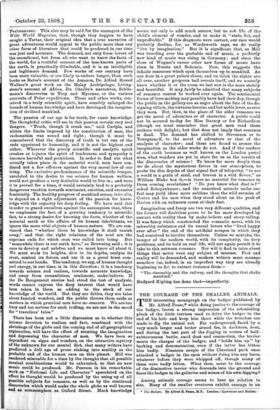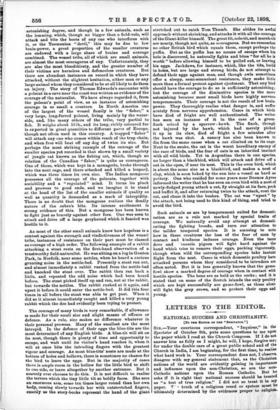THE COURAGE OF THE SMALLER ANIMALS.
THE interesting monograph on the badger published by Mr. Alfred Pease,* while doing justice to the courage of the badger, leaves a strong impression of the astonishing pluck of the little terriers used to drive the badger to the end of his hole and keep him there while the trenches are made to dig the animal out. Far underground, faced by ts very much larger and better armed foe, in darkness, heat, and during the last part of the digging in scenes of half– subterranean battle, amid dust and commotion, the terrier- meets the charges of the badger, and "holds him up" barking and demonstration, even if the latter has bitten him badly. Nineteen couple of the Cleveland pack once- attacked a badger in the open without doing him any harm. whatever before they were whipped off, though many of were badly bitten. What then, must be the courage of the diminutive terrier who descends into the ground and faces the badger in the galleries and mines of his own digging Among animals courage seems to bear no relation tp size. Many of the smaller creatures exhibit courage in an • The Badger. By Alfred B. Pease, M.P. London : Lawrence and Batten. •
astonishing degree, and though in a few animals, such as the lemming, which, though no bigger than a field-vole, will attack and bite the boots of any one who interferes with it, or the Tasmanian "devil," this may be due to low brain-power, a great proportion of the smaller creatures are endowed with a large share of brains and courage combined. The weasel tribe, all of which are small animals, are almost the most courageous of any. Unfortunately, they are also the most bloodthirsty, and the greater number of their victims are harmless and defenceless creatures. But there are abundant instances on record in which they have attacked, without the slightest hesitation, either man or any large animal whom they considered to be at all likely to do them an injury. The story of Thomas Edwards's encounter with a polecat in a cave near the coast was written as evidence of the courage of the naturalist. We have always regarded it, from the polecat's point of view, as an instance of astonishing courage in so small a creature. In North America one of the largest of the weasel family is the "fisher," a very large, long-furred polecat, living mainly by the water- side, and, like many others of the tribe, very partial to fish. It weighs about 16 lb., and its long, richly coloured fur is exported in great quantities to different parts of Europe, though not often used in this country. A trapped " fisher " will attack any one who comes within reach of the trap chain, and when free will beat off any dog of twice its size. But perhaps the most striking example of the courage of the smaller species yet recorded is that shown by a small variety of jungle cat known as the fishing cat, which, though no relation of the Canadian "fisher," is quite as courageous. One of these, which was kept in a menagerie, broke through into the next cage, and there attacked and killed a leopard, which was three times its own size. The Indian mongoose possesses all the courage of the polecats, together with amiability and a " regulated " mind. It tarns its pluck and prowess to good ends, and we imagine it to stand at the head of the list of the smaller animals if quality as well as quantity is demanded as a mark of intrepidity. There is no doubt that the mongoose realises the deadly nature of the cobra's bite. Its intense excitement is strong evidence of this. But a mongoose has been known to fight just as bravely against other foes. One was seen to attack and drive of a large greyhound which it fancied was hostile to it.
As most of the other small animals know how hopeless is a contest against the strength and vindictiveness of the weasel tribe, instances of resistance on their part must be classed as courage of a high order. The following example of a rabbit attacking a stoat rests on the first-hand observation of a trustworthy field-naturalist. He was sitting on a log in Gunton Park, in Norfolk, near some nettles, when he heard a curious grunting noise in the nettle-bed. Presently a stoat ran out, and almost immediately a rabbit rushed from the nettle-bed and knocked the stoat over. The rabbit then ran back a little, and repeated the odd noise which had been heard before. The stoat picked itself up and ran, not at the rabbit, but towards the nettles. The rabbit rushed at it again, and upset it before it could enter the nettle-bed. It did this four times in all before the stoat was able to get past. When it did so it almost immediately caught and killed a very young rabbit which the doe had evidently been trying to protect.
The courage of many birds is very remarkable, if allowance is made for their small size and slight means of offence or defence. As a rule, size makes no difference whatever in their personal prowess. Many of the smallest are the most intrepid. In the defence of their eggs the blue-tits are the most determined of any English birds. A blue-tit will sit on its nest, though there is plenty of time and opportunity to escape, and wait until its visitor's hand reaches it, when it will at once bite the intruding fingers with the greatest vigour and courage. As most blue-tits' nests are made at the bottom of holes and hollows, there is sometimes no chance for the bird to leave the eggs. Bat in the majority of cases there is ample room in the hollow for the little bird to shift to one side, or leave altogether by another entrance. But it scarcely ever chooses to do this. It is not difficult to realise the terrors which the tiny little tit so boldly faces. She sees an enormous arm, some ten times larger round than her own body, coming slowly towards her with outstretched fingers, exactly as the story-books represent the hand of the giant stretched out to catch Tom Thumb. She abides its awful approach without shrinking, and attacks it with all the courage of the Giant-killer himself. The great tit, cole-tit,and marsh-tit are nearly, though not quite, as courageous. But we remember no other British bird which equals them, except perhaps the
puffin. But as the puffin has no means of escape when his hole is discovered, he naturally fights and bites "for all he is worth" before allowing himself to be pulled out, or leaving his eggs. Jackdaws, for instance, which, like the tits, build in holes, but are large and strong birds, do not attempt to defend their eggs against man, and though owls sometimes offer a sleepy, semi-somnolent resistance, they make little more than a formal protest against ejectment. That any bird should have the courage to do so is sufficiently astonishing; but the courage of the diminutive species is the more astonishing because most small birds have highly nervous temperaments. Their courage is not the result of low brain. power. They thoroughly realise what danger is, and suffer acutely from nervous apprehension. Cases in which birth have died of fright are well authenticated. The writer has seen an instance of it in the case of a green. finch seized by a sparrow - hawk. The finch, though not injured by the hawk, which had merely picked it up in its claw, died of fright a few minutes after the hawk was shot. A. canary has also been known to die from the same cause when a cat climbed on to its cage. Next to the snake, the cat is the worst hereditary enemy of the race of birds, and the fear of cats is an inherited instinct with all wild birds. Yet in Argentina there is one species, no larger than a blackbird, which will attack and drive off a cat in the open, if near its nest. This is the oven bird, which is about the same size as a blackbird, and makes a nest of clay, which is soon baked by the sun into a vessel as hard as pottery. One who resided for some years near Buenos Ayres informed the writer that he has seen an oven bird with a nest of newly-fledged young attack a cat, fly straight at its faze, peck and buffet it, and after returning twice to the attack, rout the cat, and chase it into the bushes. The cat was " upset " by the attack, not being used to this kind of thing, and tried to avoid the bird.
Such animals as are by temperament suited for domesti- cation are as a rule not marked by special traits of courage. We naturally avoid any attempt at domesti- cating the fighting breeds, and turn our attention to the milder tempered species. It is amusing to note how in these creatures the loss of the fear of man by contact and kindness induces courage. Even the tame dove and imestic pigeon will fight hard against the hand which tries to remove their eggs, pecking vigorously, though when wild the corresponding species take instant flight from the nest. Cases in which domestic poultry have attacked persons whom they considered to be intruders are often noted. But it is less generally known that the game- fowl show a marked degree of courage when in contact with hostile species. The hens are as bold as the cocks ; and it is stated that on some of the Scotch islands the only poultry which are kept successfully are game-fowl, as these alone will fight the grey crows, and so protect their eggs and young.











































 Previous page
Previous page